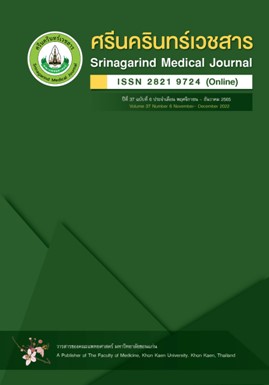Prevalence and Associated Factors of Stress in Pregnancy
Abstract
Background and Objective: The American College of Obstetricians and Gynecologists (ACOG) recommended to screen psychosocial stress during pregnancy. In Thailand, the ST-5 self-reported screening stress questionnaire was widely used in the general population because of simple to understand and easy to complete. However, no previous study had assessed the reliability and validity of the ST-5 questionnaire when used with pregnancy. The primary objective of this study was to establish the prevalence of stress in pregnancy. The secondary objectives were to evaluate the associated factors of stress and investigate the correlation between the ST-5 and Thai GHQ-28 questionnaires.
Materials and Methods: The cross-sectional study was conducted at Srinagarind Hospital, Khon Kaen University. The ST-5 and Thai GHQ-28 questionnaires were completed by pregnant women. Total scores greater than 4 of ST-5 questionnaires and more than 5 of Thai GHQ-28 questionnaires were considered for screening stress positive.
Results: Three hundred and fifty-one pregnancies were recruited. The prevalence of stress using the Thai GHQ-28 questionnaire was 13.64%. The ST-5 questionnaire showed good internal consistency with Cronbach’s alpha (α) 0.824 but low convergent validity compared with the Thai GHQ-28 questionnaire, rs 0.426 (95%CI 0.337-0.508, p < 0.001). Factors including a history of obstetric complications comorbidity, alcohol consumption and the occurrence of family members with psychiatric disorders significantly increased stress with adjusted OR 2.51 (95%CI 1.04-6.08, p = 0.040), 2.90 (95%CI 1.34-6.28, p = 0.007) and 12.19 (95%CI 2.10-70.75, p = 0.005), respectively.
Conclusion: Prevalence of stress in pregnancy was 13.64%. The ST-5 questionnaire gave a low correlation with the Thai GHQ-28 questionnaire. History of obstetric complication comorbidities, alcohol consumption or family members with psychiatric disorders were significantly increased risk of stress.
References
Woods SM, Melville JL, Guo Y, Fan MY, Gavin A. Psychosocial Stress during Pregnancy. Am J Obstet Gynecol 2010;202(1):61.e1-61.e7.
Tang X, Lu Z, Hu D, Zhong X. Influencing factors for prenatal stress, anxiety, and depression in early pregnancy among women in Chongqing, China. J Affect Disord 2019;253:292–302.
Craig M, Tata P, Regan L. Psychiatric morbidity among patients with recurrent miscarriage. J Psychosom Obstet Gynecol 2002;23(3):157–64.
Hobel C, Culhane J. Role of psychosocial and nutritional stress on poor pregnancy outcome. J Nutr 2003;133(5 Suppl 2):1709S-1717S.
Dunkel Schetter C, Tanner L. Anxiety, depression, and stress in pregnancy: implications for mothers, children, research, and practice. Curr Opin Psychiatry 2012;25(2):141–8.
The American College Obstetrician and Gynecologist Committee Opinion No. 757: Screening for perinatal depression. Obstet Gynecol 2018;132(5): e208-e212.
Alhamad A, Al-Faris EA. The validation of the general health questionnaire (GHQ-28) in a primary care setting in Saudi Arabia. J Family Community Med 1998;5(1):13–9.
Nilchaikovit T, Sukying C, Sirapakit C. Thai general health questionnaire: Thai GHQ12-28-30-60.
Bangkok: Department of Mental Health, Ministry of Public Health, 2002.
Silpakit O. Srithanya stress scale. J Ment Health Thai 2008;16(3):177–85.
Pantha S. Prevalence of stress among pregnant women attending antenatal care in a tertiary Maternity hospital in Kathmandu. J Women’s Health Care 2014;3(5):183.
Thongsomboon W, Kaewkiattikun K, Kerdcharoen N. Perceived stress and associated factors among pregnant women attending antenatal care in urban Thailand. Psychol Res Behav Manag 2020; 13:1115–22.
Boakye-Yiadom A, Shittu SO, Dutt JB, Dapare PPM, Alhassan A. Perceived stress and anxiety among Ghanaian pregnant women. J Med Biomed Sci 2015;4(2):29–37.
Rahman A, Creed F. Outcome of prenatal depression and risk factors associated with persistence in the first postnatal year: Prospective study from Rawalpindi, Pakistan. J Affect Disord 2007;100(1–3):115–21.
Silpakit O. Srithanya stress scale. J Ment Health Thai 2008; 16: 177-85.
Arch JJ. Pregnancy-specific anxiety: which women are highest and what are the alcohol-related risks? Compr Psychiatry 2013;54(3):217–28.
Goletzke J, Kocalevent RD, Hansen G, Rose M, Becher H, Hecher K, et al. Prenatal stress perception and coping strategies: Insights from a longitudinal prospective pregnancy cohort. J Psychosom Res 2017;102:8–14.
Saisto T, Salmela-Aro K, Nurmi JE, Halmesmäki E. Psychosocial characteristics of women and their partners fearing vaginal childbirth. BJOG 2001;108(5):492–8.
Martin SL, Griffin JM, Kupper LL, Petersen R, Beck-Warden M, Buescher PA. Stressful life events and physical abuse among pregnant women in North Carolina. Matern Child Health J 2001;5(3):145–52.
Vijayaselvi R, Beck MM, Abraham A, Kurian S, Regi A, Rebekah G. Risk factors for stress during antenatal period among pregnant women in tertiary care hospital of Southern India. J Clin Diagn Res 2015;9(10):QC01–5.
Fertl KI, Bergner A, Beyer R, Klapp BF, Rauchfuss M. Levels, and effects of different forms of anxiety during pregnancy after a prior miscarriage. Eur J Obstet Gynecol Reprod Biol 2009;142(1):23–9.
Lau Y, Yin L. Maternal, obstetric variables, perceived stress, and health-related quality of life among pregnant women in Macao, China. Midwifery 2011;27(5):668–73.
Rouhe H, Salmela-Aro K, Halmesmäki E, Saisto T. Fear of childbirth according to parity, gestational age, and obstetric history. BJOG 2009;116(1):67–73.
Statham H, Green JM, Kafetsios K. Who worries that something might be wrong with the baby? A prospective study of 1072 pregnant women. Birth 1997;24(4):223–33.
Lancaster CA, Gold KJ, Flynn HA, Yoo H, Marcus SM, Davis MM. Risk factors for depressive symptoms during pregnancy: a systematic review. Am J Obstet Gynecol 2010;202(1):5–14.
Bunevicius R, Kusminskas L, Bunevicius A, Nadisauskiene RJ, Jureniene K, Pop VJM. Psychosocial risk factors for depression during pregnancy. Acta Obstetricia Gynecol Scand 2009;88(5):599–605.
Waqas A, Raza N, Lodhi HW, Muhammad Z, Jamal M, Rehman A. Psychosocial Factors of Antenatal Anxiety and Depression in Pakistan: Is Social Support a Mediator? PLoS One 2015;10(1):e0116510.
Fisher J, Tran T, Duc Tran T, Dwyer T, Nguyen T, Casey GJ, et al. Prevalence and risk factors for symptoms of common mental disorders in early and late pregnancy in Vietnamese women: A prospective population-based study. J Affect Disord 2013;146(2):213–9.
Downloads
Published
How to Cite
Issue
Section
License
Copyright (c) 2022 Srinagarind Medical Journal

This work is licensed under a Creative Commons Attribution-NonCommercial-NoDerivatives 4.0 International License.




